#also. i’m NOT a design major be nice to meeee
Explore tagged Tumblr posts
Text





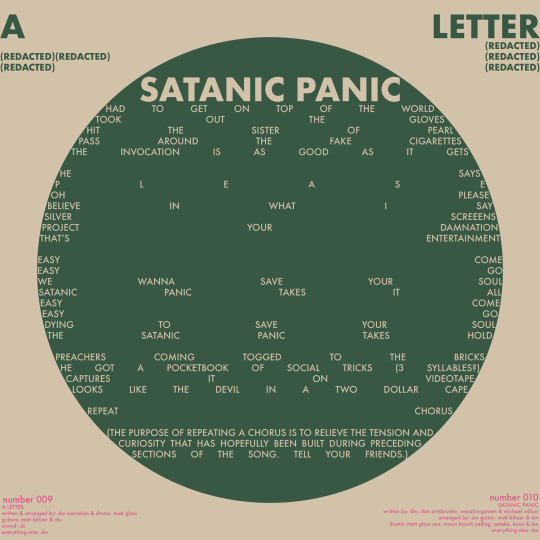


welcome to GLOOM GREEN DIVISION •
did a complete redesign of the Gloom Division CD booklet!
#greendiv my beloved#idkhow#idkhow but they found me#idkhbtfm#i don’t know how but they found me#gloom division#gloom division art#idkhow art#dallon weekes#this was for school but yknow#also. i’m NOT a design major be nice to meeee#green division
405 notes
·
View notes
Text
Summer 2018 Anime Overview: Revue Starlight
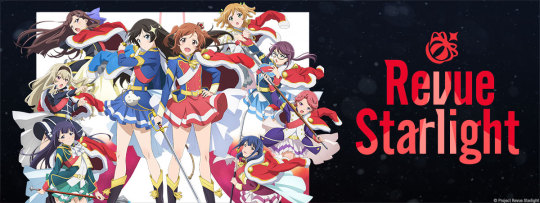
(Also known as Shoujo Kageki Revue Starlight).
Karen Aijou is training at her school to put on the annual Takarazuka play, “Starlight”. She’s shocked when her childhood friend, Hikari, suddenly appears. She follows Hikari into mysterious elevator and finds her engaged in an even more mysterious sword fight with another student that’s preceded over by a talking giraffe for some reason. She’s told that this is a competition between “Stage Girls” for the title of “Top Star”. Karen sees that Hikari is in trouble, and quickly dives to her rescue, remembering the promise she and Hikari made to become stars together. Now Karen is involved in a truly strange competition...
I was super sold on Revue Starlight from the first episode. Girls fighting with swords? Takarazuka? A random giraffe? Utena references? Nice animation? This show was made for me, clearly.

And I came out of it satisfied. It was pretty surreal and pretty gay and that’s what I’m here for. It’s hard to explain exactly what the series is about without giving away some major plot twists, I’ll put it like this- it’s very much about two girls trying to upend the vicious, cyclic system they are caught in and there are definite themes of adolescence and identity. And some characters are not what they seem. I’m always down for that.

After all, the “Top Star” system only lets one person be at the top, while the others get their dreams crushed- but Karen wants to stand together with someone. There’s a lot of light critical examination of how Takarazuka in particular is structured here- I’d really suggest checking out these posts by Atelier Emily which dig deep into the subject. Basically, there’s this understanding in Takarazuka that the “otokoyaku” (the woman who the male roles) will be top star and its the “musmeyaku” (the woman playing the female roles) must support her and consign herself to secondary status.
As Emily puts it “ [The musumeyaku must be] the perfect feminine foil so the otokoyaku’s masculine performance would stand out more in relief, [...], all while taking care not to skew too much into a romantic interest, so that young women in the audience can still imagine themselves in the arms of their favorite otokoyaku top star. Furthermore, they cannot achieve top star themselves, and must ensure that their talents do not outshine those of their otokoyaku partner.”
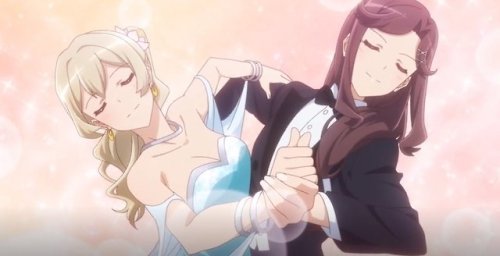
This whole dynamic plays heavily into the show- Claudine and Maya are the top otokoyaku/musumeyaku pairing in the school, yet it is Maya who gets all the attention while Claudine feels frustrated and like she’s second best. She wants to outshine Maya, but it seems like she just can’t. Meanwhile, Karen has this idea she and Hikari can be a couple who share the stage equally, which threatens to destabilize the entire system.
The series does not just examine Takarazuka but the nature of theater in general though, with the last episode in particular digging a little into the role the audience plays. It’s also touches on adolescent anxieties- we see characters coping with fear of the future and growing up, we see Mahiru struggling with her unrequited crush on Karen and her jealousy of Hikari and childhood friends finding their bond straining...of course, as expected of a series where a giraffe watches girls engage in sword fights while singing, these conflicts are expressed in a fantastical way much of the time.
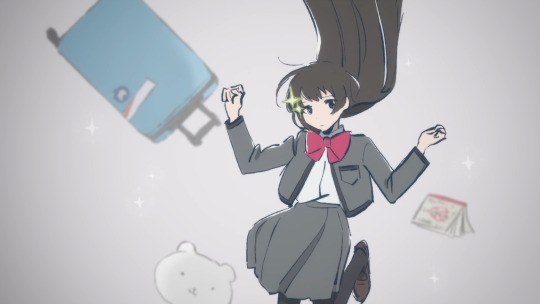
Before I go further, I should mention some cool things the series did that I really need to go back and examine- there’s a lot about the show I feel I haven’t grasped yet, and I feel I need to rewatch it before I’m able to grasp it completely. BUT I GOTTA GET THESE REVIEWS OUT BEFORE I DIVE INTO THE NEW SEASON, so this is what you get.
One thing I missed out on is that the songs the girls sing while fighting are really connected to themes of the episode- unfortunately the release I watched did not translate them, so that was lost on me. The credits sequence was also an evolving one, the lyrics would change and it would focus on a different girl or pair of girls each time- but again, not translated, so I feel like I watched an incomplete version of the show. But I will get the whole package someday because I think it’s really cool the show did that.
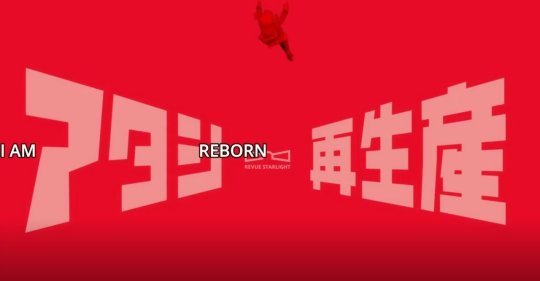
I was correct in guessing from the beginning that this series takes a ton of inspiration from Utena and also from Yuri Kuma Arashi (the director actually worked on that show) but this is very much its own thing. There are scenes in the first half that seem like they’d fit in with Love Live! or some other idol show, with girls just goofing around and ~following their dreams~, but the back half leaned way farther into the plot and metaphorical significance of the bizarre stuff that was happening.
I think the main thing Revue Starlight has going against it is character- Karen doesn’t really change much over the course of the show. She matures and is challenged a bit yes, but not in a significant way. The Karen of episode 12 makes the same decisions and has the same goals as the Karen of episode 2 essentially did. There’s not that much to her other than her determination to become the top star with Hikari, as well as her very broad “cheerful, ditzy and persistent” I’m-the-main-character-of-an-anime deal.

Hikari is a bit more complex, with some backstory and reveals about her character in store, but she also isn’t anything we haven’t seen before in a lot of ways. It was hard for me to get as invested in their relationship as I wanted- they’re just fine as characters, and they serve the themes of the show fine, but they’re so broadly sketched and kind of nebulous the emotional connection is not quite there for me.
Which is too bad, because they are EXTREMELY Gay. Don’t expect any kissing or anything ground-breaking, but the stuff they say about each other is like you know. “I only want you by my side/be with my forever/YOU’RE MINE, EVVVVERYTHINNG 222222 MEEEE THE REASSSSON I LIIIIVE IS FOR US” that sort of stuff that leaves little doubt.

The gay doesn’t stop with that.There’s also the fact that Mahiru’s is as blatant as she can be about her huge crush on Karen (she uh. goes looking for an indirect kiss at one point) and she sees Hikari as her rival, and is pretty much clearly correct. All of the other girls are clearly paired up and you’ll have them referring to each other as “my [insert name here]” or saying other stuff that barely qualifies as subtext and suggestively dancing with each other.
Like I said, nothing ground breaking, but it’s good as far as “It’s-not-as-text-as-I’d-like- but-really-barely-subtext” gay stuff goes.
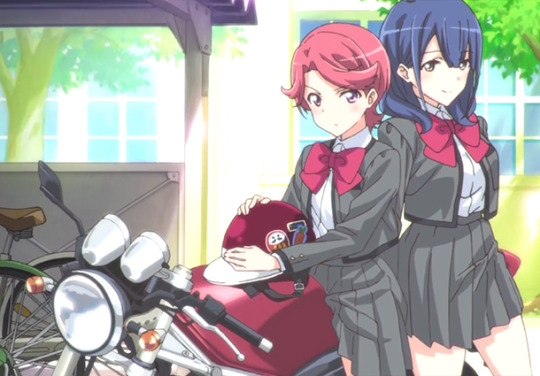
Most of our background lesbians are just a lot more interesting than the main ones, but we’re not given enough time to connect with them as much as I’d like either. Their arcs could have been more fleshed out, especially the arc of one surprising major player. I think a series with so much going on and such a big cast to explore maybe should have been a twenty-six episode deal so it could dig a little deeper with the characters and build up to things a little more.
So yeah, if I’d talk about the quality of my emotional connection and the strength of the characters and narrative and in how incisive it is, it’s not nearly as good as Utena (which I wasn’t expecting it to be, THAT’S A TALL ORDER) and more on the level of its other major influence, Yuri Kuma Arashi. It is a lot more thematically cohesive than YKA and without the deeply uncomfortable aspects, thankfully. The series may have moe character designs, but it remains classy and never indulges in blatant fanservice that I can remember.

There’s plenty of other things to touch on- there’s what seems to be light examination of the ‘bury your gays’ trope, as we find out the play “Starlight” is about a pair of HEAVILY-queer-coded-girls whose story ends with them tragically cut down and separated, and the series engages with what that show means for these girls acting it out and whether they’ll have to meet the same fate.
Honestly, it’s the kind of series you could write loads and loads of analysis for, so if you like stories you can interpret a lot and read a lot of things into, this is probably your jam. I’ve loved the discussion this series has encouraged- I advise checking out the Afictionado’s posts on the show! I can’t wait to read more about everyone’s perspectives on the show as I revisit it!

So yes, my final verdict? it’s a good show, and if you’re like me and you love stuff that centers around the relationships between girls, if you love stuff that’s full of symbolism and action and weirdness that looks at the construction of fiction and fighting unfair systems and if you think Takarazuka and musicals are cool as hell- definitely check this one out. I recommend it and there’s really nothing offputting about it I can think of. One of the “Top Stars” of the season for sure.
I’m excited to give it a rewatch and pick up all the things I missed the first time. Right now, It’s not in my top ten or anything and I can’t say it moved me deeply. it was just a bit to nebulous in a lot of ways- but its definitely a worthy addition to the “lesbians with swords” genre, and in the end, what better compliment can there be than that?
#revue starlight#shojo kageki revue starlight#karen aijou#aijou karen#karen aijo#hikari kagura#kagura hikari#maya tendou#tendou maya#claudine saijou#Mahiru Tsuyuzaki#anime overview#summer 2018 anime
48 notes
·
View notes